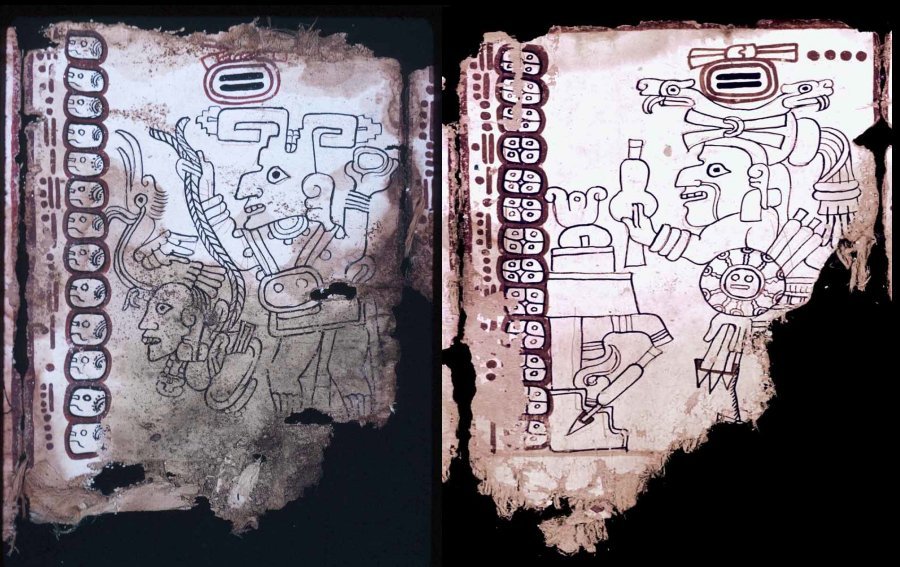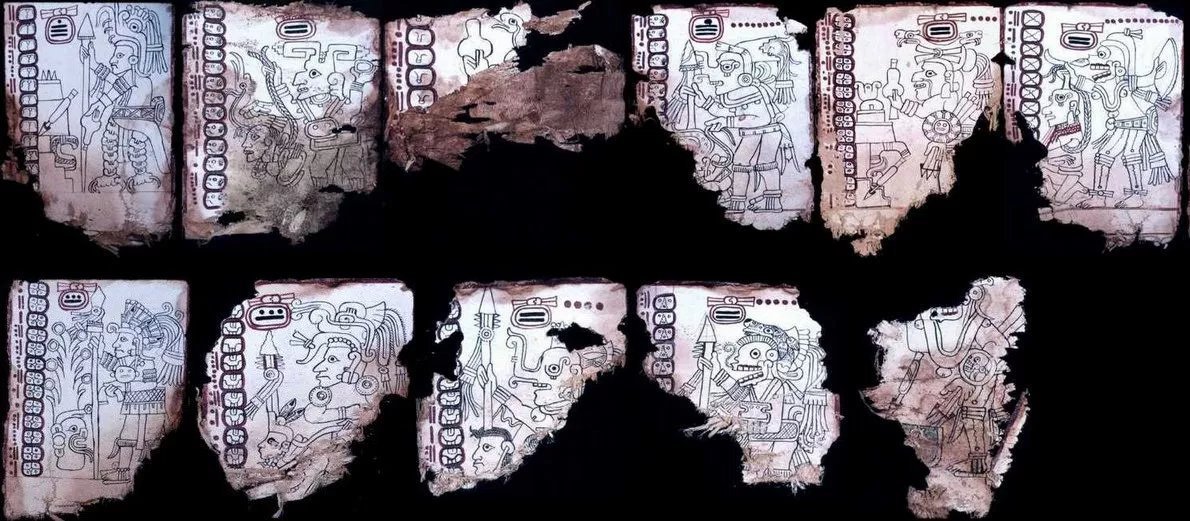Grolier Codex – Oldest, Unique, Genuine Pre-Columbian Maya Manuscript That Survived Spanish Inquisition
A. Sutherland - AncientPages.com - The ancient Maya created many books, but almost all of them were burned by conquistadors and clergy. One of those who significantly contributed to the destruction of the Maya cultural material was the Yucatan bishop Diego de Landa (1524 – 1579).
Left: Page 6 of the Grolier Codex, depicting a death god with captive. Image credit: Private Collection via Wikipedia; Right: Codex Grolier. Image credit: Instituto Nacional de Antropología e Historia, Mexico
The original manuscript has been lost in the "Relación de las Cosas de Yucatán" (around 1566), but many copies still exist; de Landa wrote valuable information about the religion, language, and culture of the Maya.
However, during the ceremony on July 12, 1562, many Maya codices (according to Landa, 27 books) and approximately 5000 Maya cult images were destroyed by the Inquisition Tribunal called by the bishop.
It first appeared in a private collection in the 20th century and was displayed at the Grolier Club in New York. The codex consists of a fragment of a Maya book, containing almanacs of Venus represented in a somewhat simplified fashion, compared to the known Maya codices.
The Grolier Codex would be only the fourth surviving pre-Columbian Maya book if genuine. The manuscript would once have measured 250 centimeters (98.4 in), and was approximately the size of the Dresden Codex.
Codex Grolier, page 7. Upploaded by Adamt - Public Domain
Looters discovered it in a cave in Chiapas, Mexico, in the 1960s. After careful studies, this important manuscript has been confirmed as genuine and probably the most ancient of all surviving manuscripts from old America.
tored in the treasury at the National Anthropological Museum, Mexico, the Grolier Codex contains little text and a lot of illustrations.
Only a fragment of the Codex survived. It consists of 10 painted pages ornamented with ritual Maya iconography, tablets of Venus covering 104 years (probably three generations of the Maya priests), and a calendar that charts the movement of the planet Venus.
Venus and its cycles were significant for the Maya and all Mesoamerican peoples, who believed that different gods and deities were strongly associated with these cycles and with the passing of time.
Codex Grolier. Image credit: Instituto Nacional de Antropología e Historia, Mexico
The Maya regularly measured Venus' cycles because it could help them organize ritual cycles based on astronomical phenomena.
The Grolier Codex differs much from the Dresden Codex, which mentions a great variety of Maya gods and consists of many calculations and detailed notes made by its authors.
Instead, the Grolier Codex only describes the gods who are "deities of everyday life" of the Maya people. These gods are responsible for events such as death, sunlight, or lightning phenomenon, strongly associated with K'awiil, a Maya deity identified with lightning, maize, serpents, and fertility.
The Maya were excellent astronomers who recorded and interpreted every aspect of the sky. They had their solar calendar and knew the timing of the eclipses. The stars, moons, sun, and planets were regarded as gods.
These Gods were involved in human affairs, and their movements were watched closely. The Maya dedicated much time to studying celestial objects, and several of their most important buildings were constructed with astronomy in mind.
Written by A. Sutherland AncientPages.com Staff Writer
Updated on January 12, 2023
Copyright © AncientPages.com All rights reserved. This material may not be published, broadcast, rewritten or redistributed in whole or part without the express written permission of AncientPages.com
Expand for referencesMcClellan J. E. Dorn H. Science and Technology in World History
More From Ancient Pages
-
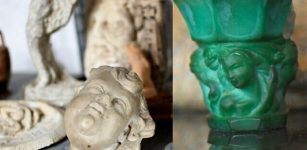 Thousands Of Spectacular Stolen Ancient Treasures Discovered Hidden In Major Bust
Artifacts | Jan 5, 2021
Thousands Of Spectacular Stolen Ancient Treasures Discovered Hidden In Major Bust
Artifacts | Jan 5, 2021 -
 Hidden 2,000-Year-Old Roman Road Uncovered In Worcestershire Could Be Of ‘Global Importance’
Archaeology | Nov 12, 2022
Hidden 2,000-Year-Old Roman Road Uncovered In Worcestershire Could Be Of ‘Global Importance’
Archaeology | Nov 12, 2022 -
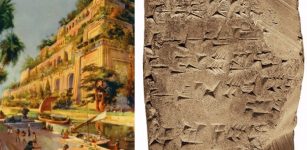 Modern Banking Concept Started In Ancient Babylonian Temples
Ancient History Facts | Mar 7, 2016
Modern Banking Concept Started In Ancient Babylonian Temples
Ancient History Facts | Mar 7, 2016 -
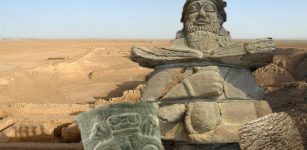 Enmerkar: Legendary Sumerian Founder And Ruler Of Uruk And Grandson Of God Utu
Featured Stories | Mar 23, 2020
Enmerkar: Legendary Sumerian Founder And Ruler Of Uruk And Grandson Of God Utu
Featured Stories | Mar 23, 2020 -
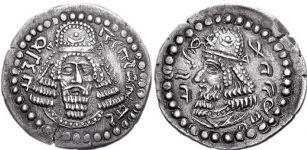 The Rise And Fall Of The Sasanian Empire
Civilizations | Jun 19, 2019
The Rise And Fall Of The Sasanian Empire
Civilizations | Jun 19, 2019 -
 Ancient Mysteries Of Wisconsin – Great Forgotten Prehistoric Events Shed New Light On History Of North America
Featured Stories | Jan 11, 2019
Ancient Mysteries Of Wisconsin – Great Forgotten Prehistoric Events Shed New Light On History Of North America
Featured Stories | Jan 11, 2019 -
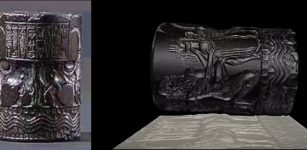 Sharkalishharri Cylinder Seal From The Fifth King Akkad Dynasty
Artifacts | Feb 14, 2016
Sharkalishharri Cylinder Seal From The Fifth King Akkad Dynasty
Artifacts | Feb 14, 2016 -
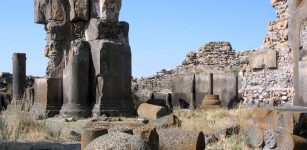 Ancient Great City Of Ani: Lost Capital Of The Kingdom Of Armenia And Its Mysterious Underground Tunnels
Featured Stories | Feb 18, 2016
Ancient Great City Of Ani: Lost Capital Of The Kingdom Of Armenia And Its Mysterious Underground Tunnels
Featured Stories | Feb 18, 2016 -
 Mysterious Underground City In Brazil Could Re-Write Ancient History – Unexplained Artifacts And Skeletons – Part 1
Featured Stories | Jan 23, 2022
Mysterious Underground City In Brazil Could Re-Write Ancient History – Unexplained Artifacts And Skeletons – Part 1
Featured Stories | Jan 23, 2022 -
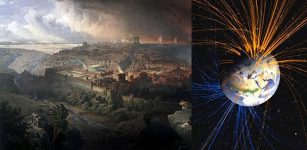 Ruins Of Ancient Jerusalem Shed New Light On Earth’s Magnetic Field’s Behavior
Ancient Symbols | Aug 11, 2020
Ruins Of Ancient Jerusalem Shed New Light On Earth’s Magnetic Field’s Behavior
Ancient Symbols | Aug 11, 2020 -
 Scientists Say Large Mammals Shaped The Evolution Of Humans – Here Is What Happened
Featured Stories | Jan 27, 2023
Scientists Say Large Mammals Shaped The Evolution Of Humans – Here Is What Happened
Featured Stories | Jan 27, 2023 -
 Very Rare Ancient Roman Horse Brooch Discovered In UK
Archaeology | Mar 7, 2020
Very Rare Ancient Roman Horse Brooch Discovered In UK
Archaeology | Mar 7, 2020 -
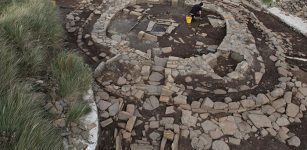 Ancient DNA Reveals Bronze Age Women Altered Genetic Landscape Of Orkney
Archaeology | Feb 7, 2022
Ancient DNA Reveals Bronze Age Women Altered Genetic Landscape Of Orkney
Archaeology | Feb 7, 2022 -
 Bronze Age Royal Tombs Unearthed In Ruins Of Ancient City Of Pylos, Greece
Archaeology | Dec 30, 2019
Bronze Age Royal Tombs Unearthed In Ruins Of Ancient City Of Pylos, Greece
Archaeology | Dec 30, 2019 -
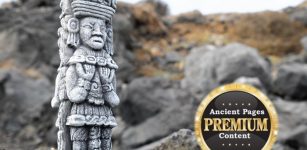 Mystery Of Giant Ancient Statues And A Vanished Civilization With Unusual Physical Characteristics – Strange American Connection – Part 2
Civilizations | Aug 20, 2020
Mystery Of Giant Ancient Statues And A Vanished Civilization With Unusual Physical Characteristics – Strange American Connection – Part 2
Civilizations | Aug 20, 2020 -
 Londinium: Ancient Roman Outpost That Became Powerful City Of London
Featured Stories | Aug 16, 2018
Londinium: Ancient Roman Outpost That Became Powerful City Of London
Featured Stories | Aug 16, 2018 -
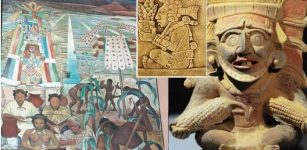 Yum Kaax, Mayan God Of Agriculture, Lord Of Woods And Caretaker Of Animals
Featured Stories | Jul 15, 2020
Yum Kaax, Mayan God Of Agriculture, Lord Of Woods And Caretaker Of Animals
Featured Stories | Jul 15, 2020 -
 Ancient DNA’s Analysis Delivers Crucial Clues To Migratory Patterns During The First Millennium AD
DNA | Jan 2, 2025
Ancient DNA’s Analysis Delivers Crucial Clues To Migratory Patterns During The First Millennium AD
DNA | Jan 2, 2025 -
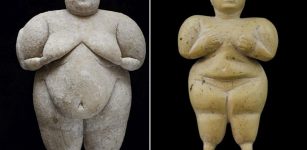 Figurines Unearthed At 9,000-Year-Old Çatalhöyük Site Symbolize Elderly Women, Not Goddess Cybele
Archaeology | Mar 1, 2017
Figurines Unearthed At 9,000-Year-Old Çatalhöyük Site Symbolize Elderly Women, Not Goddess Cybele
Archaeology | Mar 1, 2017 -
 DNA Sheds Light On Ancient History Of Dogs All The Way To The Ice Age
Archaeology | Oct 30, 2020
DNA Sheds Light On Ancient History Of Dogs All The Way To The Ice Age
Archaeology | Oct 30, 2020

